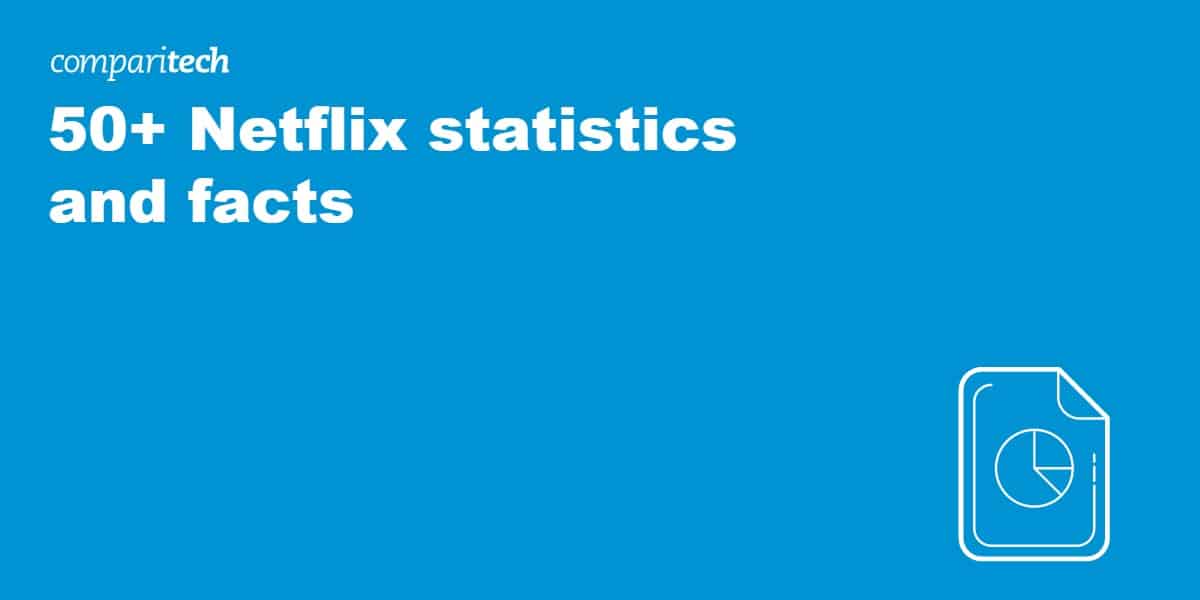
There are no two ways about it: Netflix has had a tough year but is still absolutely dominating the streaming video market. According to the Q2 2022 figures, Netflix now has approximately 220 million global paid memberships, and remains the largest premium video on-demand service in the world.
For perspective, Netflix competitor Hulu ended Q2 of 2022 with 45.6 million subscribers in total. While researching the use of VPNs to securely access Netflix, we struggled to find a really comprehensive source of Netflix statistics, facts, and figures so decided to compile our own.
Netflix is a fairly multi-faceted company. With so much attention pouring its way, industry observers have been collecting reams of data on the company for over a decade now. Most Netflix facts and stats focus heavily on the company’s growth numbers and market value, but there’s much more to the streaming service than that. And not all of it paints a rosy picture for the company.
What numbers matter most for the streaming giant? Here are 50+ Netflix stats and facts that reveal just how big Netflix has become.
1. Despite more competition, Netflix still ha2 the largest subscriber count in 2022
While the #2 streaming service, Amazon Prime, may be able to boast about its equally large subscriber base (estimated at 200 million in April 2021), it’s unclear how many of its Amazon Prime members are using its Prime Video service. In Q2 2022, Netflix announced it had 220 million subscribers now turning to Netflix worldwide.
Technically, Disney has around 221 million subscribers, but its figures count Hulu and ESPN+, which come bundled with Disney+ as two additional subscriptions and don’t accurately list the number of paying customers. Still, with Disney+ alone accounting for 44 million subscriptions, it’s clear Netflix has plenty of work to do.
2. Around 75 million US and Canadian adults have a Netflix subscription
Netflix now combines the US and Canada into its regional subscriber count totals. According to the company, those two countries account for 73 million (.xlsx) of its users. That’s a loss of almost 1.3 million North American users in six months.
According to research from Ampere, about four-fifths of people aged 18 to 34 in the US are either Netflix subscribers or have access to the service through their families or shared passwords.
3.Account sharing and monetization efforts
In 2023, a significant number of Netflix subscribers in the United States shared their accounts with family, friends, or other relatives. Approximately 27% shared with family members, indicating widespread account-sharing practices. Recognizing this trend’s potential for revenue generation, Netflix announced plans to monetize password sharing. This move was intended to give subscribers more control over their accounts while tapping into a new revenue stream, affecting over 100 million households globally. For more details, see the full report on DemandSage.
4. The company is older than most users realize
Media attention on Netflix has taken off in the past decade, but the streaming service was under the radar for years before that. The following stats chart the company’s most notable milestones as it grew from a small DVD service to a streaming media giant. Netflix was founded in 1997. The company’s site launched a year later.
5. Netflix dominates despite struggling in its early years
Initially, Netflix only received $2 million in venture capital funding during its Series A funding round from Reed Hastings. Just three years later, during its Series E funding round, it only raised $50 million with three backers.
Now the company is raking in almost $8 billion per year (2022), with estimated operating profits of $5.9 billion. These are impressive figures, however, it is worth noting that the expansion of Netflix is now slowing with the company beginning to lose customers en-masse to its rivals.
6. Netflix was incorporating more technology than its competitors much earlier on
The company began offering a subscription-based DVD-by-mail service in 1999. In 2000, Netflix began using a combination of collected big data and analytics tools to recommend videos for users to rent.
After reaching 4 million subscribers in 2004, and realizing the potential higher-bandwidth internet could provide, Netflix launched online video streaming in 2007 alongside its dominant DVD-by-mail option.
7. Netflix was one of the first streaming services available as an app on different devices
Netflix moved beyond web browsers in 2008, partnering with companies to stream on Xbox 360, Blu-ray disc players, and TV set-top boxes. In 2009, Netflix landed on the PS3 and smart TVs. By 2010, Netflix rounded the bases for streaming devices, launching on Apple’s iPad, iPhone, iPod Touch, Nintendo Wii, and more.
8. Netflix was the first true international streaming service of its kind
Netflix officially branched out to international markets in 2010 with its Canadian launch. 2011 marked a major year for Netflix as the streaming service dove further into the international market, launching in Latin America and the Caribbean. Netflix finally migrated to Europe in 2012, officially becoming available in the UK, Ireland, and Nordic countries.
Netflix continued its march across the globe in 2015, finally launching its service in Australia, New Zealand, Japan, and other locations. As of 2022, Netflix is available worldwide except for a select few countries.
9. The company is responsible for the ongoing streaming wars
The massive growth in streaming around the globe has led to what is being described by analysts as the streaming wars. Most agree that Netflix’s dominance in the US – as well as its successful expansion worldwide – has put it in the driving seat, with few competing streaming platforms managing to keep up.
This dominance is in part due to Netflix’s heavy investment in originals; content that it either buys the rights to outright or produces itself in order to be able to broadcast it in all global regions.
In 2013, Netflix launched its first three big-budget original series, House of Cards, Hemlock Grove, and Orange Is the New Black. The streaming service pulled in 31 primetime Emmy nominations for those original shows.
Since then the streaming giant has produced over 1500 originals, including Money Heist, The Queen’s Gambit, and of course, Stranger Things. However, the most popular Netflix original of all time to date is Squid Game. This was sampled by 111 million accounts and has been streamed for 1.65 billion hours collectively. That’s 188,356 years of time spent watching just one of the platform’s many titles.

10. Its popularity caused major ISPs to throttle Netflix streaming
In 2014, after loads of complaints from customers, Comcast and Netflix reached a “mutually beneficial” agreement to help stop throttling issues. Reports state that Netflix paid Comcast to end the dispute.
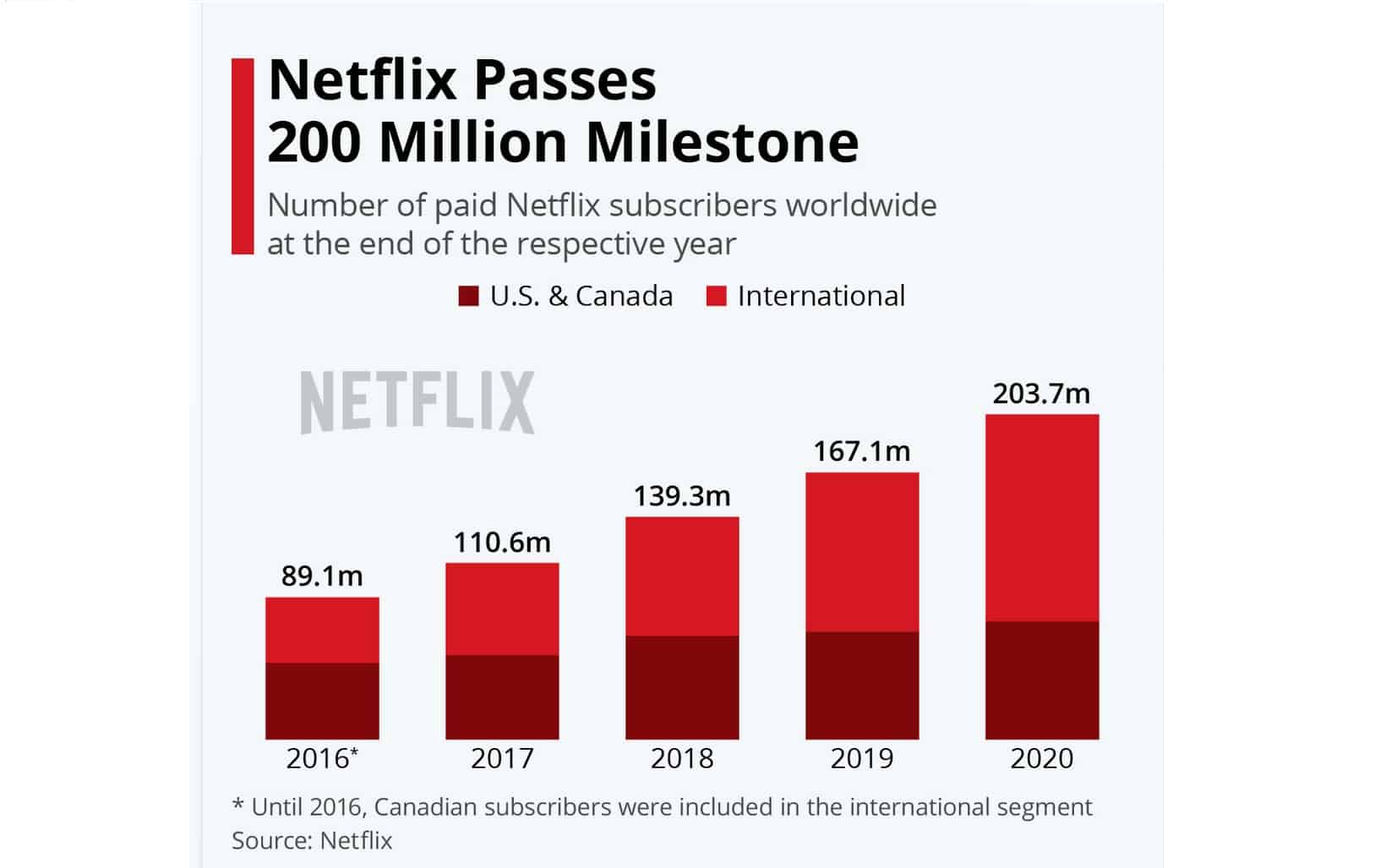
11. Netflix set the stage for an aggressive fight against region-hopping through VPNs and other proxies
Even as Netflix was available worldwide, the company began to aggressively crack down on region hoppers. On February 29, 2016, reports began rolling in that the streaming service was blocking virtual private networks (VPNs) and other proxy services.
However, in 2020, things changed. Now, if Netflix detects that a user is connected to a VPN, they are only shown titles that they would normally be able to watch in their home country. Of course, Netflix’s VPN-detection methods aren’t infallible, so there’s something of an arms race between the company and VPN providers.
12. Netflix toppled HBO’s long-running Emmy nomination streak
In 2017, Netflix won its first Oscar. The service’s original content The White Helmets won in the Best Documentary Short Subject category. It followed up with another for Best Documentary Feature (American Factory) in 2020. Further, Laura Dern won Best Actress in a Supporting Role for her performance in Netflix Original Marriage Story.
As of 2018, Netflix officially beat HBO’s 17-year-long run in Emmy nominations. The streaming service received 160 Emmy nominations in 2020, up starkly from the 90 it received in 2017. As of 2020, Netflix had received 225 Emmy nominations, with 43 awards won.
In 2021, Netflix massively extended that record by gaining 129 nominations; of which it won a staggering 44 awards. This set the Emmys record for most wins in a single year, which had previously been held by CBS since 1974.
13. The company’s Academy Awards (Oscars) showing is also top-level
In 2017, Netflix won its first Oscar. The service’s original content The White Helmets won in the Best Documentary Short Subject category. In 2022, Netflix lead the pack with 27 Oscar nominations, 12 of which belong to its film The Power of the Dog.
14. Netflix users watch and use a lot of streaming data
As of 2020, Netflix users watched an average of 3.2 hours of video per day through the service—that’s 6 billion collective hours per month. If we assume that each hour of streaming uses 3GB of data, this means we’re each using around 288 GB per month on Netflix alone. Of course, this assumes you’re watching HD video; if you prefer to stream in 4K, your data usage will likely be significantly higher.
15. ‘The Night agent’ was the most popular Netflix TV show in Q1-Q2 2023, and ‘The Mother’ was the most popular Movie
The Night Agent Season 1 emerged as the most popular TV series on Netflix in the first half of 2023, with viewers watching over 882.1 million hours of the show. On the movie front, “The Mother,” starring Jennifer Lopez, led the pack with 249.9 million hours of streams, becoming the most-watched movie on the platform. These figures highlight the diverse interests of Netflix’s global audience and the platform’s ability to produce highly engaging content. For further information, visit Yahoo News.
16. The average Netflix user has watched 62 days’ worth of TV shows and movies since creating an account
As detailed in our Time Spent Streaming post, viewers in the US, UK, Australia, and Canada sure do love their Netflix, watching more than the typical viewer.
On average, Americans have streamed 88,643 minutes, or 62 days of Netflix, which is 16 days more than the average. They also spend a whopping 85% of their viewing time on TV series.
As for the British, they’ve enjoyed an average of 78,874 minutes or 55 days of Netflix, bingeing for 9 days more than the average person. Meanwhile, Australians have watched just a bit more than the average user, clocking in 67,817 minutes or 47 days of Netflix, which is only one day more than average. Around 78% of the titles viewed in both countries are TV series.
But let’s hear it for the Canadians, who take the crown as the top binge-watchers among this group! They’ve spent an impressive 94,648 minutes or 66 days on average watching Netflix, outpacing the average viewer by 20 days. Plus, over 80% of their viewed content consists of TV series.
17. The 2020 Coronavirus pandemic caused an unprecedented amount of Netflix streaming
In a letter to shareholders, Netflix revealed that it had gained an additional 15.77 million subscribers in the first quarter of 2020 alone as billions of people around the world were forced into quarantine and social distancing.
A key fact: Netflix was forced to reduce streaming quality in several countries to help reduce strain on overtaxed bandwidth.
Meanwhile, Google searches for Netflix surged in March 2020 as more people were forced into quarantine. By March 22, Google searches for “Netflix” surged to its highest point in 12 months when compared to Disney+ and Amazon Prime Video.
18. Netflix users spent a combined 164 million hours per day watching content in 2019
According to statistics from 2019, Netflix viewers across all of its available countries watched around 164 million hours per day of content. Netflix has not released similar numbers since 2017 but has started releasing total viewing stats for select original content.
19. 45% of Netflix’s worldwide revenue comes from North America
While Netflix is available in almost every country in the world, its home base is still its most important one. Of the 220 million Netflix subscribers, more than 73 million are in the United States and Canada, with the US leading the pack.
North America has generated paid subscription revenue of $3 billion, which is around 45% of worldwide revenue. In Q2 2022, the average monthly revenue per paying subscriber differed by region as follows:
- US and Canada: $15.95
- Europe, Middle East, and Africa: $11.17
- Latin America: $8.67
- Asia-Pacific: $8.83
20. Netflix spent $2.2 billion on research and development in 2021
The streaming giant spends a massive amount of money on “research and development”. In 2021, the company spent over $2.2 billion in this category, constituting an 18 percent increase over its 2020 R&D spending. By comparison, Netflix spent $953.7 million on R&D in 2017.
21. Netflix reported almost $29.7 billion in revenue in 2021
The streaming giant continues to earn big each year. Benefiting from larger subscriber growth as well as price increases, Netflix reported total net revenue of close to $29.7 billion per year in 2021. The company’s annual revenue was $11.69 billion just four years previous in 2017, marking an 87 percent increase from 2017 to 2021.
Perhaps more impressively, Netflix’s revenue growth is up 2400 percent since 2007, the year the company introduced its digital on-demand streaming option alongside its DVD-by-mail service.
22. Netflix earned over $200 million in 2021 from its DVD rental service
Although the company began as a DVD-by-mail rental service, it’s significantly scaled back that aspect after introducing the digital on-demand streaming option in 2007. Nonetheless, Netflix is still earning a healthy (but diminishing) profit from DVD rentals. As of 2021, the company earned $200 million from DVD rentals, unchanged from the year before. The company last reported over 2.1 million customers still signed up solely for the DVD service in 2019.
However, the company’s DVD revenue and membership have been on the decline for years as more customers switch to on-demand. In 2017, the company made around $450 million in revenue from its DVD rental service, which indicates a 47 percent decrease in DVD rental revenue from 2017 to 2021.
23. Netflix subscribers are increasingly willing to pay more for the service
In May 2020, 55% of surveyed users said they would be willing to pay more to use the service. This is a rise of 8% since December 2019 when 47% of users reported they would pay more than they currently do.
24. Prior to the release of Disney+, Netflix paid $300 million to stream Disney’s content
A key draw for Netflix users, before Disney+ launched, was its exclusive access to Disney’s animated films and other content. Netflix paid $300 million to stream Disney content. Disney, in turn, likely used some of that revenue to build its own service, which is now the only place most users can legally stream Marvel and Disney movies.
25. Netflix’s shares plummet over 20% in 2022, its worst day since July 2021
Netflix shares dropped 21.8% on Friday, January 21, 2022, after the company admitted in its Q4 earnings release that streaming competition was eating into its own growth. The price has continued to fall since, then, hitting all time low of $331.01 USD on March 14. This plummeting of shares marked Netflix’s worst day in two years.
26. Netflix plans to be cash-flow positive every year after 2021
Although the company earns billions each year, its net income in 2019 was small as most of that money went right back out the door. Netflix had a negative free cash flow of $3.3 billion in 2019. However, it saw a positive free cash flow of $1.9 billion in 2020. The company stated it planned to be cash-flow neutral in 2021 and cash-flow positive every year after that.
The majority of the company’s negative free cash flow is in spending on new original content, which it hopes to make up for in new subscriptions.
27. Netflix is no longer outspending its competition on content
If there are two words one could use to best define the streaming wars, it’s these: “Original content”. Netflix used to be the service spending the most on content (and especially original content). But this is no longer the case.
According to research from Wells Fargo, Netflix ranks fourth place in terms of total projected 2022 spending ($19 billion, up 13% from 2021). When sports are removed, it ranks second. In contrast, Warner Bros. Discovery will spend $22.4 billion in 2022 (including sports), while Walt Disney Co. will spend $33 billion on content.
28. Debtflix: Netflix carried over $18 billion in debt in 2021
Netflix carries a large amount of debt that it’s still paying off. The company reportedly held $18.8 billion in debt in 2021, and according to estimates, the company’s debt will rise to $20.2 billion in 2022. This may sound like a bad thing, but at least one industry observer notes that Netflix is doing just fine financing its growth with debt.
29. Netflix is worth over $105 billion as of October 2022
The company has seen its value grow rapidly over the years. As of October 2022, Netflix had a market cap of over $105 billion. That might sound impressive, but just six months before, its market cap was $160 billion.
30. Slovakia has the largest Netflix library in 2022
Although Netflix content libraries shift in size almost daily, some countries regularly maintain larger library sizes than others. Slovakia currently has the largest library of Netflix content, with 7,990 titles as of October 2022.
31. Liechtenstein’s Netflix library is the least cost-effective for subscribers, while Pakistan offers the best deal
Differences in library sizes result in Netflix subscribers paying vastly different amounts on a per-title basis. Netflix subscribers in Liechtenstein on a Standard subscription pay $0.00162 per title, with a library size of approximately 5,982 titles. In contrast, Netflix subscribers in Pakistan pay just $0.00029 per title and have access to a larger library of over 5,974 titles.
32. The service employs around 11,300 workers
Netflix employs roughly 11,300 people. By comparison, the company had slightly fewer than 1,000 employees at the end of 2005, marking a dramatic increase in its payroll over the past 17 years. Between 2019 and 2020, Netflix added 1,900 employees—the largest number of new employees brought in by the company over the course of 12 months in its history.
33. Netflix users prefer large screens but mobile viewing on the rise
In 2019, Leichtman Research Group found that 85 percent of Netflix users stream the service on a TV, indicating that most users have either a TV-connected streaming device like a Roku or Amazon Fire TV, or a smart TV (or both).
However, in 2022, Netflix said that half of its subcribers watch on mobile devices every month. There were a couple of interesting notes here: first, that mobile viewing only accounts for about 10 percent of a person’s total screentime, and that the attention span of a mobile viewer appears to be about 40 minutes.
34. Netflix has over 17,000 titles globally as of October 2022
Data from uNoGS indicates that Netflix had at least 17,300 titles across all its international libraries as of October 2022. This is a sizeable increase from the 15,400 titles it offered in January 2018.
35. Netflix has produced over 1,500 original titles since it began producing original content in 2013
The company produces two kinds of original content—TV shows and movies that it pays for and develops in-house, and TV shows and movies that it acquires that acquire the exclusive rights to broadcast. Netflix tends to put the term “Netflix Original” on both, adding notable difficulty to pin down the exact number of TV shows and movies that it’s actually produced in-house.
The company’s first true original show was award-winning House of Cards.
36. TV shows accounted for 82 percent of Netflix’s top-rated original content in 2019
Netflix pours massive amounts of money into the number and quality of its serials, and it shows in the numbers. While the service had 35 original titles earn a “Certified Fresh” score on Rotten Tomatoes in 2019, 82 percent (29) of those were serials. Only nine of the licensed programs it released in 2019 were “Certified Fresh”.
37. Netflix’s personalized recommendation engine could be worth $1 billion per year (or more)
According to Business Insider Australia, Netflix believes its personalized recommendation engine is worth big bucks; roughly $1 billion per year, in fact.
38. Around 80 percent of Netflix users take the streaming service’s title recommendations offered by its algorithm
While users quite often land on the most popular shows, the vast majority of Netflix users also click to watch the recommended shows from the Netflix recommendation algorithm, in fact 80 percent of Netflix views were from the service’s recommendations.
39. ‘Criminal Minds’ is the top-watched licensed show on Netflix as of 2021
According to 2022 data from Nielsen, Criminal Minds was the top-watched licensed show on Netflix in 2021, with nearly 34 billion minutes watched. The show has overtaken The Office as the most-streamed show. Other popular shows were Grey’s Anatomy (32.6 billion minutes) and NCIS (29.5 billion minutes).
40. 34 million viewers tuned in to watch ‘Tiger King’ in its first 10 days
Netflix’s murder documentary Tiger King: Murder, Mayhem, and Madness notched up 34 million viewers within the first 10 days. As with many things these days, its fast rise in popularity was spurred on by social media, and in particular, an explosion of memes that help drive interest in the show.
41. Netflix has received over 800 nominations and over 250 awards for its original content
The company’s original content strategy is about more than just volume. The company is actively pursuing awards as part of its Netflix’s original programming has received over 800 award nominations and 250 awards given. The Crown holds 129 of those awards.
42. Netflix is willing to spend $20 million per hour of original content
The company is in the streaming wars to win it, and it’s putting its money where its digital mouth is. According to Netflix CFO David Wells, the company is not opposed to spending $20 million per hour of original content.
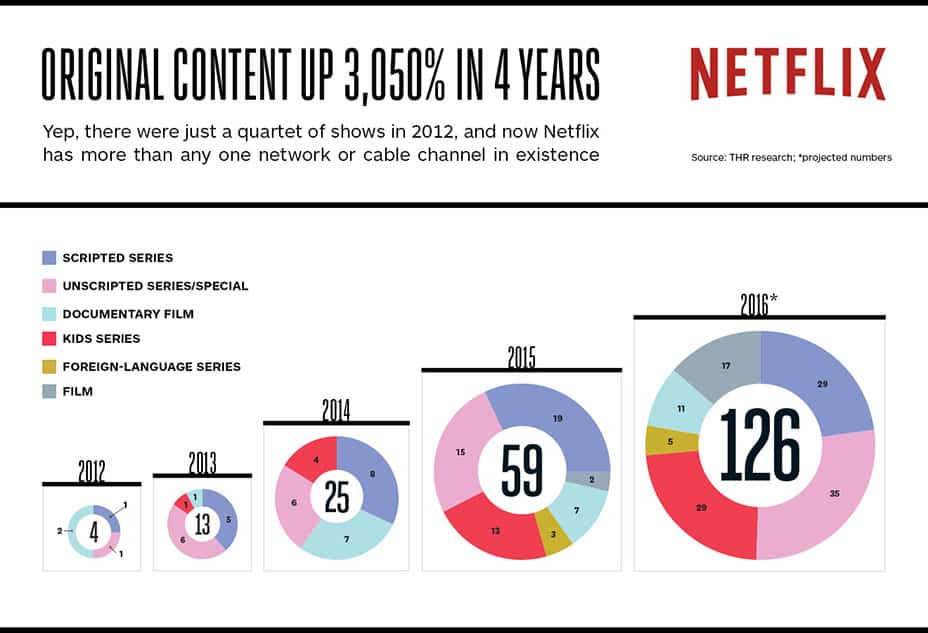
43. Netflix’s show ‘The Crown’ cost $10 million per episode
A drama based on the British royalty, the Netflix original series The Crown cost an estimated $13 million per episode. The sci-fi hit Stranger Things was a runner up with an estimated $12 million per episode.
44. Netflix is paying comedians tens of millions of dollars to produce stand-up performances
Netflix is also spending big on individual comedians, especially if they’re well known and can draw in subscribers. The company paid Chris Rock $40 million to produce two comedy specials and paid Dave Chapelle $60 million for a three-part stand-up special.
45. Netflix data shows many top providers offer the same ISP speeds, with small providers also offering the fastest speeds
Through its ISP Speed Index, Netflix regularly tracks and publishes primetime streaming speeds from all major ISPs in most countries it serves. While the index doesn’t (and can’t) provide the total speed an ISP can offer, it does give a reasonable snapshot of an ISP’s capabilities.
In the US, as of December 2021, the fastest ISP speed is 3.6 Mbps, offered by Comcast. AT&T and Frontier take second place with 3.4 Mbps.
Netflix recommends a minimum of 5 Mbps for HD-quality streaming, meaning a large percentage of subscribers are streaming in SD quality or less. Very few are streaming in Ultra HD, which Netflix suggests requires 15 Mbps in available bandwidth.
46. Netflix offers content in over 60 languages
Netflix offers its offer content in over 60 languages. In 2017, the company attempted to massively outsource its translation needs to thousands of individual translators worldwide. That effort lasted just one year. The company shut down its HERMES operation just a year later due to the complexity of onboarding and managing so many translators. Instead, the company outsources the work to a few dozen translation and localization services.
47. Netflix accounts for 17 percent of all worldwide online video subscriptions
According to the MPAA’s 2021 Theme Report, there were 1.3 billion online video subscriptions as of the end of 2021 (an increase of 200,000,000 on 2020). Based on its current worldwide subscription numbers (220 million), that means Netflix commands 16.9% of the global digital streaming market.
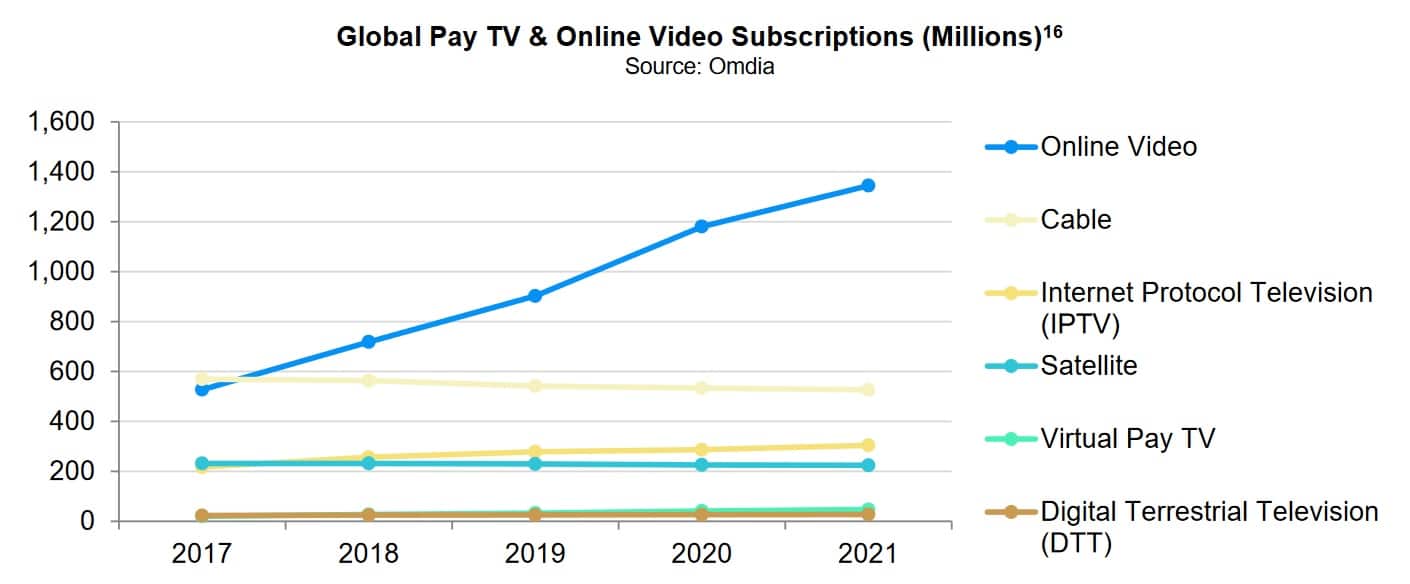
The global streaming market is rising faster than Netflix’s subscriber base, meaning its year-over-year market share is slowly declining as more competition comes online.
48. Because most people subscribe to multiple services, around 30 percent of streaming service users subscribe to Netflix
Although around 17 percent of streaming service subscriptions go to Netflix, about a third of people have a Netflix subscription. According to eMarketer, just under 30 percent of individuals worldwide who have one or more subscription services also subscribe to Netflix.
49. Gen Z prefers watching on-demand via OTT services than live TV
There’s a generational split when it comes to how we watch TV. Gen Z, for instance, vastly prefers streaming, with one-third reporting that they don’t ever watch live TV. Boomers lean the other way, with 36% claiming that they don’t use any streaming services.
50. Netflix single-handedly accounts for 9.39 percent of all downstream internet traffic worldwide
In its most recent Global Internet Phenomena Report, Sandvine notes that Netflix accounted for 9.39 percent of all global downstream traffic volume in the first half of 2022.
51. Netflix accounts for over 26% of downstream traffic in EMEA countries
While the average downstream percent worldwide is around 12 percent, there are significant regional variances. In the EMEA region, Netflix streaming accounts for 26.09 percent of all downstream traffic.
52. All Netflix subscribers have at least six shows they watch in common
According to Netflix, all of its customers have at least six shows or movies they watch in common. The service sees this as an interesting, unifying factor among its wide customer base.
53. The gender gap between Netflix viewers is almost non-existent
According to a report from Finances online, men and women are watching a similar amount of Netflix as each other, with 49% of viewers being male, up against 51% of viewers being female. This figure shows that Netflix is doing well to appeal to both audiences.
54. 47% of Americans preferred Netflix over any other platform in 2021
Just when you thought other big streaming giants were hot on the heels of Netflix, stealing a chunk of its well-earned subscribers, New10 reports that Disney Plus and Hulu only had the vote of 13.6% and 13% of Americans, respectively, while Amazon Prime swooped 14%.
55. Netflix password sharing in the UK is up by 27%
The Guardian reports that around 27% of Netflix subscribers in the United Kingdom share their account passwords with other households. While this figure seems high, the upcoming introduction of password sharing fees will likely decrease this figure.
Netflix 2024 and beyond
All signs continue to point toward a bright future for Netflix, but 2023 and beyond could be slower years for the company. It continues to lose subscribers to rival services (though at a slower rate than anticipated) and the plans to curb password sharing will likely see a further exodus.
Spending on original content is already starting to plateau but Netflix’s big hitters like Stranger Things tend be one of the main reasons customers stick around. To avoid subscriber churn, it’ll have to demonstrate that it has more value than other services. One of the big ways it’s doing this is with the inclusion of video games, so expect to see a marketing blitz touting this as a major advantage for subscribers.
Read more Netflix articles here:
- Free Netflix? Several sites offering instructions to bypass Netflix sign-up
- Netflix Subscribers and Revenue by Country
- How much does Netflix cost per month? – Comparitech
- Want a free VPN for Netflix? Try this tested June 2024
- Netflix vs Amazon vs Hulu vs Disney+: Which offers the best value for money? – Comparitech
Netflix FAQs
What's the difference between Netflix Basic, Standard, and Premium plans?
Netflix offers three subscription plans to cater to different preferences:
- Basic: With this plan, you can stream on one device at a time in standard definition (SD).
- Standard: This plan allows streaming on two devices simultaneously in high definition (HD).
- Premium: The top-tier plan lets you stream on up to four devices simultaneously in ultra-high definition (UHD) and high definition (HD).
How many languages does Netflix support for content?
Netflix boasts an impressive selection of over 30 languages for its content. You can choose your preferred language for both audio and subtitles, making it easy to enjoy your favorite shows and movies in your native language or any language of your choosing. Take advantage of the chance to explore the diverse world of Netflix in the language that suits you best!


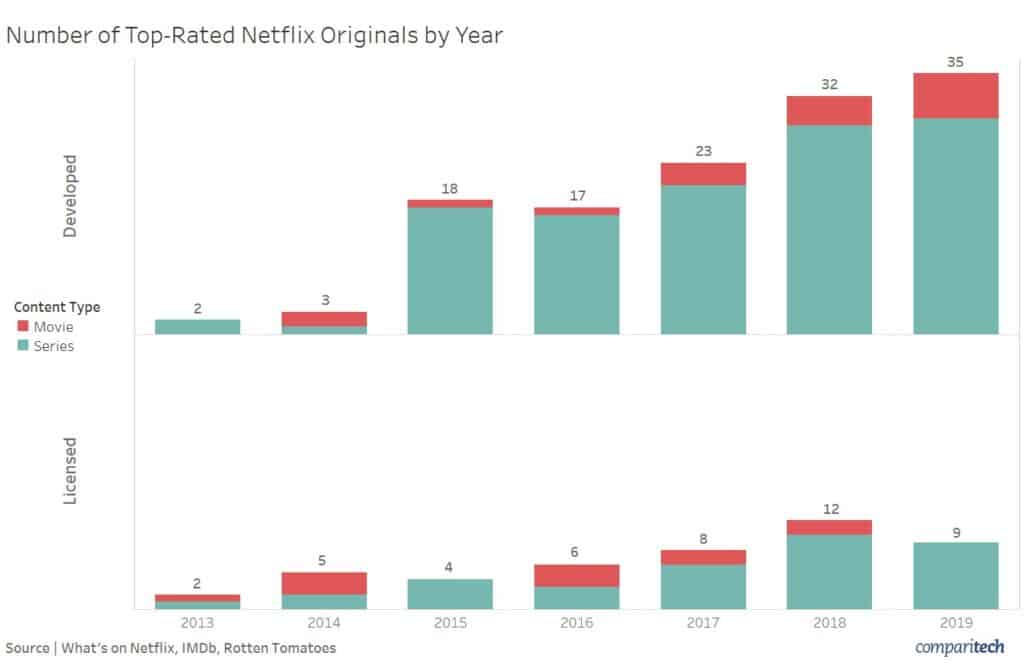

Okay! You poked me with a pointed stick. Now help me heal the wound.
What are the 6 shows/movies that tie us all together?
Hi Ted! Here’s the company page on that (I linked it in the doc as well, now).
https://media.netflix.com/en/company-blog/we-all-have-6-shows-in-common
Funny enough, Netflix appears to have pulled the video they made of it after receiving some pushback on its methodology.
Great info, thanks for the deep research and data analysis.